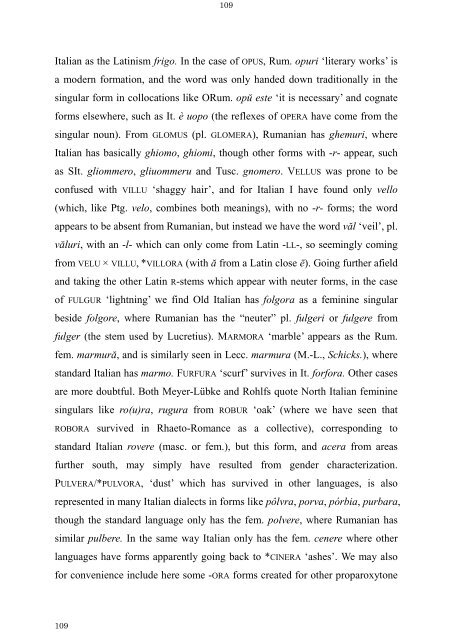The Latin Neuter Plurals in Romance - Page ON
The Latin Neuter Plurals in Romance - Page ON
The Latin Neuter Plurals in Romance - Page ON
You also want an ePaper? Increase the reach of your titles
YUMPU automatically turns print PDFs into web optimized ePapers that Google loves.
109<br />
109<br />
Italian as the <strong>Lat<strong>in</strong></strong>ism frigo. In the case of OPUS, Rum. opuri ‘literary works’ is<br />
a modern formation, and the word was only handed down traditionally <strong>in</strong> the<br />
s<strong>in</strong>gular form <strong>in</strong> collocations like ORum. opŭ este ‘it is necessary’ and cognate<br />
forms elsewhere, such as It. è uopo (the reflexes of OPERA have come from the<br />
s<strong>in</strong>gular noun). From GLOMUS (pl. GLOMERA), Rumanian has ghemuri, where<br />
Italian has basically ghiomo, ghiomi, though other forms with -r- appear, such<br />
as SIt. gliommero, gliuommeru and Tusc. gnomero. VELLUS was prone to be<br />
confused with VILLU ‘shaggy hair’, and for Italian I have found only vello<br />
(which, like Ptg. velo, comb<strong>in</strong>es both mean<strong>in</strong>gs), with no -r- forms; the word<br />
appears to be absent from Rumanian, but <strong>in</strong>stead we have the word văl ‘veil’, pl.<br />
văluri, with an -l- which can only come from <strong>Lat<strong>in</strong></strong> -LL-, so seem<strong>in</strong>gly com<strong>in</strong>g<br />
from VELU × VILLU, *VILLORA (with ă from a <strong>Lat<strong>in</strong></strong> close ē). Go<strong>in</strong>g further afield<br />
and tak<strong>in</strong>g the other <strong>Lat<strong>in</strong></strong> R-stems which appear with neuter forms, <strong>in</strong> the case<br />
of FULGUR ‘lightn<strong>in</strong>g’ we f<strong>in</strong>d Old Italian has folgora as a fem<strong>in</strong><strong>in</strong>e s<strong>in</strong>gular<br />
beside folgore, where Rumanian has the “neuter” pl. fulgeri or fulgere from<br />
fulger (the stem used by Lucretius). MARMORA ‘marble’ appears as the Rum.<br />
fem. marmură, and is similarly seen <strong>in</strong> Lecc. marmura (M.-L., Schicks.), where<br />
standard Italian has marmo. FURFURA ‘scurf’ survives <strong>in</strong> It. forfora. Other cases<br />
are more doubtful. Both Meyer-Lübke and Rohlfs quote North Italian fem<strong>in</strong><strong>in</strong>e<br />
s<strong>in</strong>gulars like ro(u)ra, rugura from ROBUR ‘oak’ (where we have seen that<br />
ROBORA survived <strong>in</strong> Rhaeto-<strong>Romance</strong> as a collective), correspond<strong>in</strong>g to<br />
standard Italian rovere (masc. or fem.), but this form, and acera from areas<br />
further south, may simply have resulted from gender characterization.<br />
PULVERA/*PULVORA, ‘dust’ which has survived <strong>in</strong> other languages, is also<br />
represented <strong>in</strong> many Italian dialects <strong>in</strong> forms like pôlvra, porva, pórbia, purbara,<br />
though the standard language only has the fem. polvere, where Rumanian has<br />
similar pulbere. In the same way Italian only has the fem. cenere where other<br />
languages have forms apparently go<strong>in</strong>g back to *CINERA ‘ashes’. We may also<br />
for convenience <strong>in</strong>clude here some -ORA forms created for other proparoxytone









